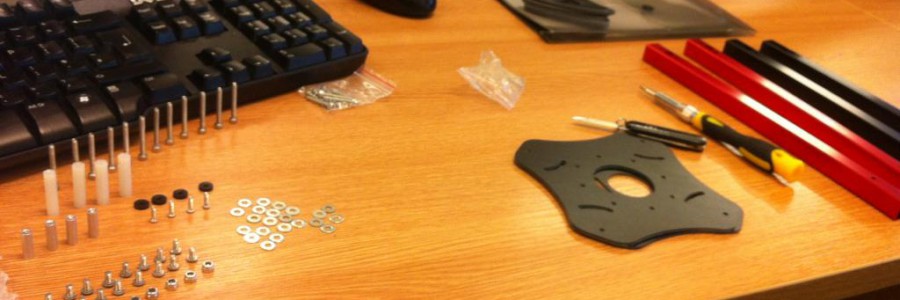Unmanned Aerial Vehicles (UAV’s) have become an increasingly area of study in the last years. This kind of vehicle does not require a human pilot to be physically present inside the aircraft which allows it to be used in dangerous situations or in hazardous environments (such as disaster areas). An specific class of these aerial vehicles know as quad-rotors (aircraft with 4 rotors) which are specially researched because of its capacity for hovered flights.
This part of the report proposes the design and test of an UAV quad-rotor prototype capable of act as a particle in a swarm of robots. Its important to mention that the embedded systems also know as avionics is based on popular DIY (do it yourself), open-hardware systems available to buy everywhere, we have bench-tested 3 of those systems.
AlduxQuad is my second quadcopter built and the first documented one.
The frame is made from aluminium (550mm from rotor to rotor), two arms are black and the rest are red, just to have a better view of the X when flying.
Brushless motors don’t have the mechanisms necessary to rotate by itself so to make them rotate is necessary to use a device to energize each phase to generate the rotation correctly, hence the ESC’s. This motors are commonly chosen by their Kv rating. This rating refers to the rpm constant of the motor, is the number of revolutions per minute that the motor will turn when 1 volt is applied with no load attached to the motor. Is important to note that Kv does not have nothing to do with Kilovolt, is just a common way of referring to the constant by the manufacturers. Its more related to the power out of the motor, the torque level of it, its determined by the number of winds in the armature and the strength of the magnets, is a value that is always delivered by the manufacturer.
It’s important to mention that adjacent motors in the quad-rotor rotates on opposite directions. This is necessary because the total centripetal force generated by the rotation of the motors would make the quad-rotor rotate in the opposite direction to the rotation of the motors. Four propellers are used, two propellers for clockwise rotation and two for counter clockwise. The adjacent propellers have opposite attack angles because the clockwise motor demands clockwise propellers and the counter clockwise motor demands counter clockwise propellers.
I choose Turnigy brushless motors with 1050kv and a max current of 19amps.
The correct motor/prop combination needs to be chosen by considering the size and weight of the quad-rotor, the length of flying time and the power and agility desired. Propellers are listed by length and pitch typically ranging from 8 inches for higher Kv motors to as long as 12 inches for lower Kv motors. The size used in the actual quad-rotor are 10 inches with a 4.5 pitch because we selected a middle Kv motor.
The LiPo is a rechargeable battery that has the characteristics like high drive electrical current capacity, high charge storage capacity, several charge-discharge cycles. This batteries are chosen by 3 factors: power (amperes); the number of cells (voltage, each cell delivers 3.7 volts); discharge rate (its the capacity to discharge).
I have tested mainly 2 IMU autopilots that are available in the market today, the suggested platforms have similar structures, one is the Ardupilot (APM) and the other is MultiWii flight controller (MW).





